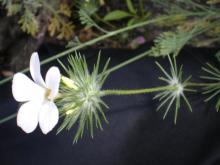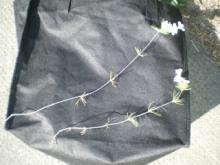This plant showed up last summer and I am having trouble identifying it.
It might have come in as part of a mix.
Comments
Re: ?Linanthus nuttallii or gilia nuttallii?
Wow, what an incredible set of photos at Calflora (the last link)... I'm smitten too!
I hope your plant produces seed, Caroline - it's very pretty.
Re: ?Linanthus nuttallii or gilia nuttallii?
Does anyone know of a source that offers a good assortment of Linanthus sp. seed?
Re: ?Linanthus nuttallii or gilia nuttallii?
Does anyone know of a source that offers a good assortment of Linanthus sp. seed?
After a quickie google search, found this one, lots of nice colorful California annuals; I would welcome many of them to color up the summer garden if they'd grow... they do have Linanthus grandiflorus, said to be very fragrant, and in several tinges of color.
http://www.larnerseeds.com/_pages/wildflower_annual.html
Now promise me Lori, you're not going to buy them out before I've had a chance! ;)
Re: ?Linanthus nuttallii or gilia nuttallii?
Oh, come now, would I do that?!? ;D ;D
I'm very tempted to get the wildflower mixes to cast around in an empty spot or two. (Imagine that... wildflower mixes made of actual native wildflowers. ;))
Re: ?Linanthus nuttallii or gilia nuttallii?
Holy moly, I was googling around for Linanthus seed, and discovered that a version of Abram's "An Illustrated Flora of the Pacific States" is completely online, for free, as a Google eBook. This link should take you to the Linanthus section, with L. grandiflorus found on Page 426!
Re: ?Linanthus nuttallii or gilia nuttallii?
Oh, come now, would I do that?!? ;D ;D
I'm very tempted to get the wildflower mixes to cast around in an empty spot or two. (Imagine that... wildflower mixes made of actual native wildflowers. ;))
Tell me, Lori, do you say that Californian wildflowers are native to your Albertan pastures? :o
I have tried to spread annuals around both native and foreign but the problem is: I have no empty space!
Re: ?Linanthus nuttallii or gilia nuttallii?
Tell me, Lori, do you say that Californian wildflowers are native to your Albertan pastures? :o
I meant that all the species in the mix are native to the same place/habitat, presumably, as opposed to so many so-called "wildflower" mixes that are half European weed species!
Re: ?Linanthus nuttallii or gilia nuttallii?
I posted my response to the leptodactylon thread by mistake. The plant pictured is Linanthus grandiflorus. An annual, you just scatter the seed and sometimes get a very impressive stand.
Bob
Re: ?Linanthus nuttallii or gilia nuttallii?
Thanks for the help with my mystery Linanthus or mystery Leptosiphon.
And thanks for the links to while away a snowy afternoon in Alberta.
Caroline



Hello Caroline,
I love a good mystery, and this one just sent me down a long review of the genus Linanthus; I blissfully while away the hours when I'm supposed to be working and studying this weekend! Even though these are annuals, I'm totally smitten with their charm and now want to create a sandy/rocky bed for these little delights. Seems that most of them are Californian, although there are species that range throughout the western states, and most species are now designated as Leptosiphon. Since I give a bunch of CalPhoto links here, they still use Linanthus rather than Leptosiphon, so I will refer to them here as Linanthus.
I think you were close with Linanthus nuttallii (and there are 4 subspecies, so this plant takes many forms).
http://plants.usda.gov/java/profile?symbol=LENU8
Once I combed through some floras and the CalPhotos, I believe the closest match is Linanthus grandiflorus. It also looks similar to L. nuttallii and L. pachyphyllus, but I'd bet money on L. grandiflorus. :)
Linanthus grandiflorus
http://calphotos.berkeley.edu/cgi/img_query?enlarge=0000+0000+0606+1090
http://calphotos.berkeley.edu/cgi/img_query?enlarge=0000+0000+0403+0936
http://calphotos.berkeley.edu/cgi/img_query?enlarge=8253+3202+0179+0107
...great closeup:
http://calphotos.berkeley.edu/cgi/img_query?enlarge=0000+0000+0606+1096
Linanthus nuttallii (bushier, leaf internodes closer together)
http://calphotos.berkeley.edu/cgi/img_query?enlarge=6105+1651+0976+0061
http://calphotos.berkeley.edu/cgi/img_query?enlarge=1335+3153+0216+0004
...some forms are rather dense growing:
http://calphotos.berkeley.edu/cgi/img_query?enlarge=0000+0000+0708+0201
Linanthus pachyphyllus
http://calphotos.berkeley.edu/cgi/img_query?enlarge=0000+0000+0805+0583
http://calphotos.berkeley.edu/cgi/img_query?enlarge=0000+0000+0706+0708
...based on the closeup detail, the involucre bracts and terminal leaves are more entire, less dissected:
http://calphotos.berkeley.edu/cgi/img_query?enlarge=0000+0000+0706+0710
To while away hours of Linanthus oogling, start here:
http://calphotos.berkeley.edu/cgi/img_query?query_src=photos_index&where-lifeform=any&rel-taxon=contains&where-taxon=Linanthus&rel-namesoup=matchphrase&where-namesoup=&rel-location=matchphrase&where-location=&rel-county=eq&where-county=any&rel-state=eq&where-state=any&rel-country=eq&where-country=any&where-collectn=any&rel-photographer=contains&where-photographer=&rel-kwid=equals&where-kwid=&max_rows=24